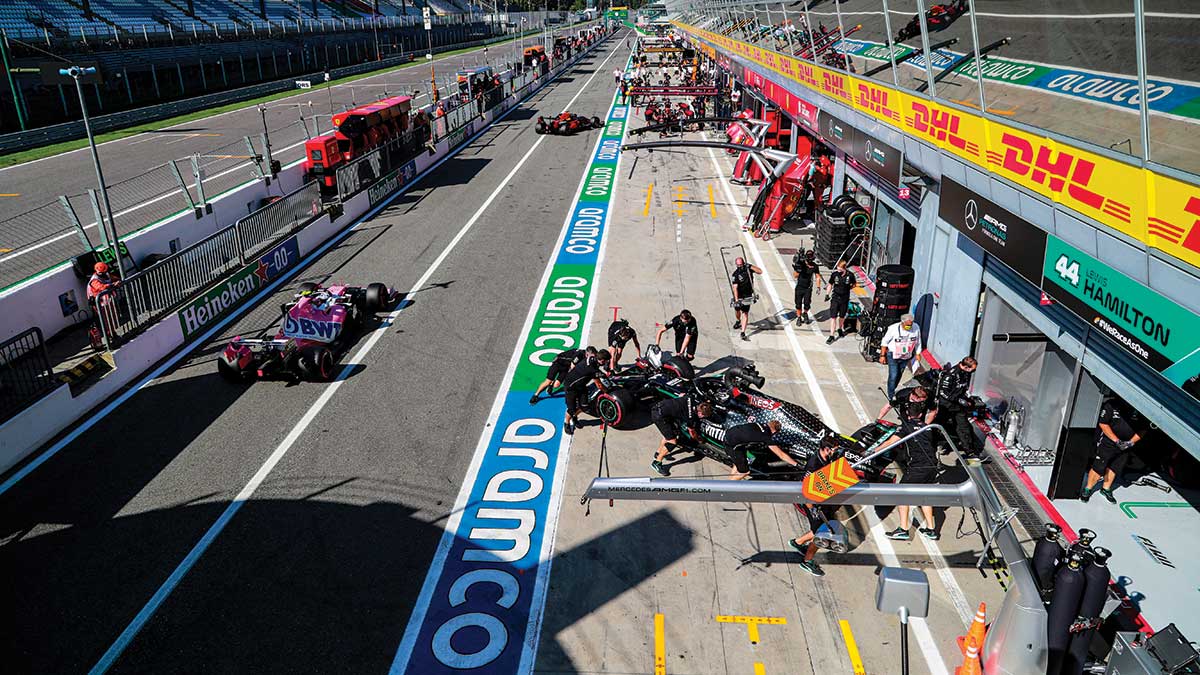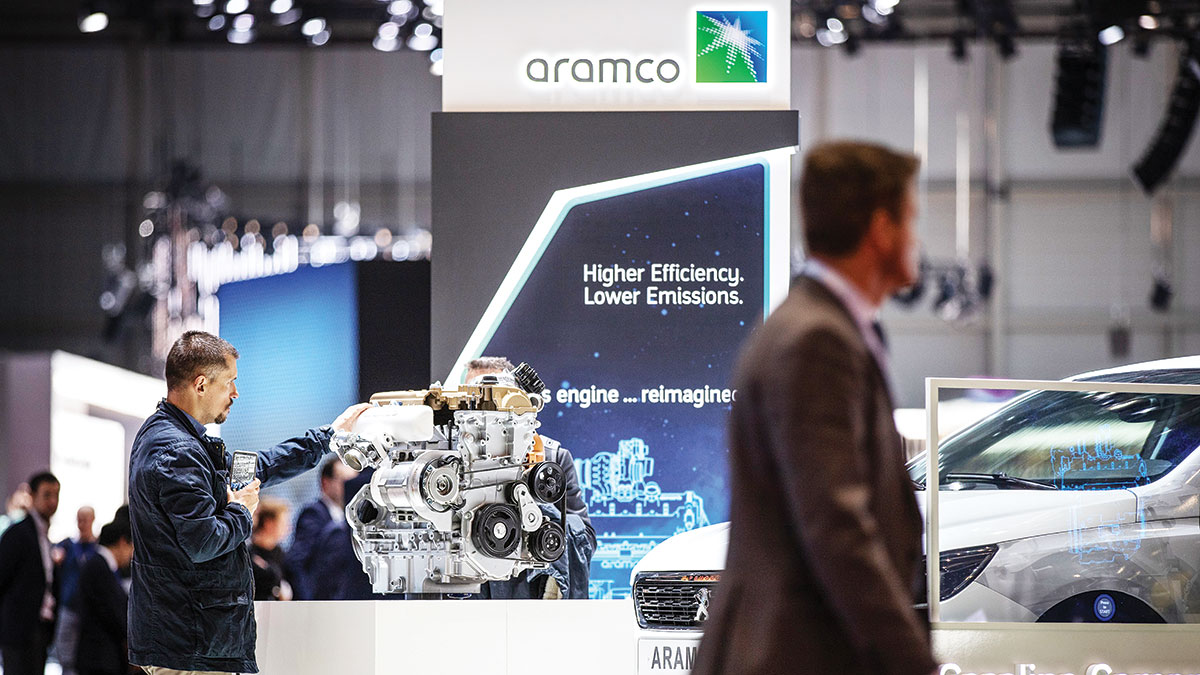Tweaking fuels and engines
Aramco and F1 innovating engines of the future.

Global September 30, 2020 - By
Research into more efficient solutions is both good for business, and good for the environment.
Aramco and Formula 1 (F1) are both at the pinnacle of their industries. One is the world’s most valuable energy and petrochemical company, and the other is the world’s fastest and most exciting sport.
But the two have more in common than you might think.
Both are at the forefront of vehicle innovation with a shared commitment to making the internal combustion engine (ICE) more energy efficient, exploring opportunities to enhance vehicle efficiency and to realize carbon dioxide (CO2) reduction benefits, both in the sport and across the global transport sector. The outcome of this research could have a dramatic effect on the cars that we drive in the future, thereby reducing emissions and pollutants while enhancing safety and efficiency, as well as improving overall driving experience.
You may not immediately think of F1 racing when you drive to and from work every day, but F1 advancements have directly benefited the wider automotive industry in a number of ways, including aerodynamic innovations, safety developments, and energy recovery systems. Also, composite materials from F1 have been adopted by the automobile and other industries.
Tweaking fuels and engines
Now, think of the range of technologies being explored by our network of research and development labs around the world. Many of these technologies are available today, or in the very near future, including gasoline compression ignition (GCI), turbulent jet ignition, opposed piston engine, and mobile carbon capture. Working with original engine manufacturers, Aramco’s researchers are working to deliver up to 50% of CO2 avoidance.
For example, GCI technology optimizes both the fuel and the engine as a system, achieving a 17% reduction in CO2 compared to the best of today’s gasoline spark ignition engines. A vehicle with GCI technology only produces 84 grams of CO2 per kilometer, well below the European Union’s target for 2020 of 95 grams.
Research into more efficient solutions is both good for business, and good for the environment. The global economy is forecast to double in size by 2050, while approximately 2 billion more people will need access to affordable energy. Today, electric vehicles (EV) account for less than 2% of the 1.2 billion vehicle fleet around the world. Even if the EV sector of the market continues growing at the current pace, they will only account for 10% of market share. Projections show that by 2040, ICEs will remain the major driver for the transportation sector, accounting for more than 85% of the global market.

What this means is that our collective future will require innovation on all fronts. Electrification is part of the solution for the transportation sector, but the ICE industry will also have to play a role. If we are serious about making significant reductions in carbon emissions, we must rethink the engine that most of the world will continue to use for some time.
All that cutting-edge research doesn’t just stay in laboratories. It trickles into every aspect of our daily lives. In a real sense, today’s latest auto engine research is similar to the space-age research of the late 20th century. Consider just a few products that came from the space race — infrared thermometers, artificial limbs, wireless headsets, LED lighting, portable cordless vacuums, freeze-dried foods, memory foam, and scratch-resistant eyeglass lenses, to name a few.
Rethinking the engine
Like Aramco, F1 drives continuous innovation to make the ICE — the world’s leading engine for transport — more efficient.
Today’s F1 V-6 turbo-hybrid power unit is a marvel of automotive engineering. Powerful enough for drivers to accelerate from zero to 100 km per hour (kph) in 2.6 seconds, with top speeds of 360 kph, the F1 engine has also been tweaked to make it more efficient, resulting in lowered emissions. Compared with the V-8 used by F1 teams up to 2013, today’s V-6 has gained 20% more power while reducing CO2 emissions by 26%, with thermal efficiencies and energy recovery of over 50%.
And F1 is not stopping there, as it has announced its first ever sustainability strategy, including the intention to take emissions reduction to the next level in future engine designs, delivering not only net-zero carbon race cars but also a net-zero carbon sport by 2030.
Research partnership
With their new partnership, Aramco and F1 are looking to leverage new technologies to significantly improve performance and reduce overall transport-based greenhouse gas emissions.
Ahmad O. Al-Khowaiter, Aramco’s chief technology officer, told CNBC recently that the company is collaborating with auto manufacturers to develop fuels that are optimal for their GCI systems, while also researching ways to make gasoline spark ignition engines as efficient as diesel, but without the emissions challenges of diesel.
“We are really excited about this partnership with F1 because it opens up a whole new range of technologies” Al-Khowaiter said.
Aramco and F1 plan to explore opportunities to cooperate on vehicle efficiency and to realize carbon reduction benefits both in the sport and across the global transport sector. Both Aramco and F1 see opportunities in enhanced engine efficiency, optimized low carbon fuels, emissions reduction, along with lightweight and carbon management solutions.
“We have been working on bringing the ICE (forward), bringing that efficiency, doubling that efficiency, or improving that efficiency dramatically,” Al-Khowaiter said.
So we are working hard with automakers and with partners to bring some of these advanced technologies into the average car.
— Ahmad O. Al-Khowaiter
Aligning Aramco with a sport such as F1, therefore, is more than just a high-profile place to put our company logo. Rather, it gives the company a global stage to present our commitment and forays in innovation in the transport industry, making a stronger case that the ICE and petroleum-based fuels are here to stay, and will be key to the world’s transportation needs for decades to come. It also allows us to show that we are serious about the sustainability of the automotive industry when it comes to challenges such as climate change, and that Aramco plays a leading role in finding the solutions that reduce emissions and that can be deployed at scale.
So remember that when you watch your next exciting F1 Grand Prix. There is much more to the sport of auto racing than a machine that goes vroom. Moreover, the research that made those powerful, energy efficient engines possible could dramatically improve the quality of life of global citizens for generations to come.



